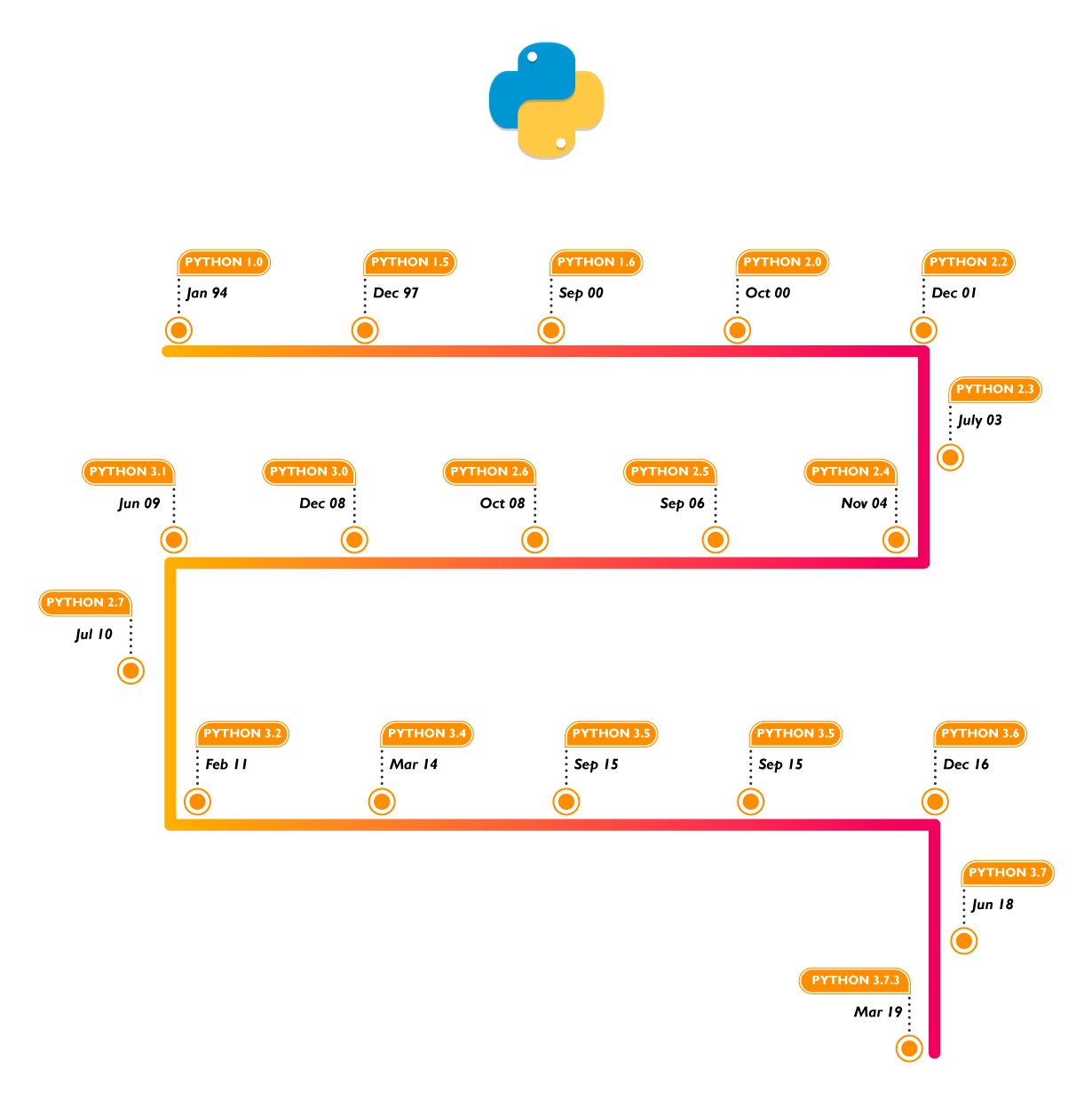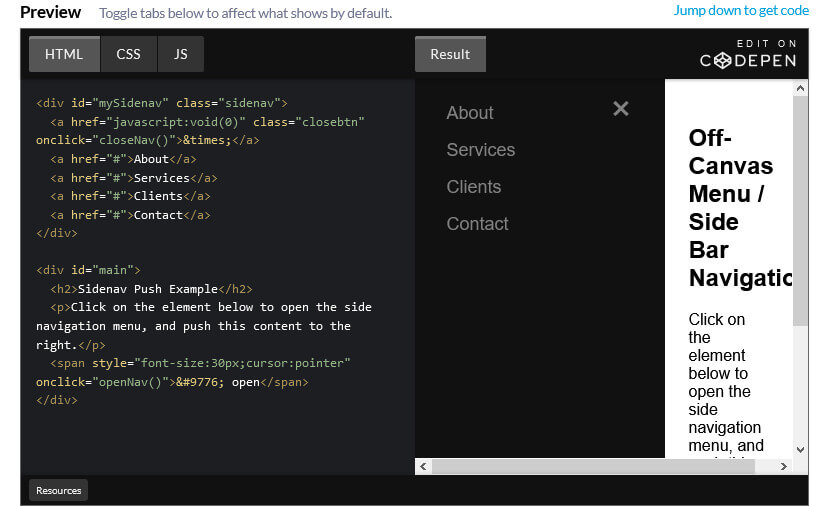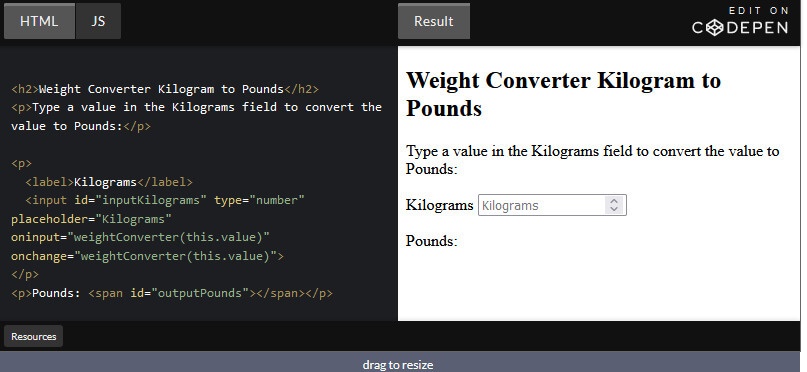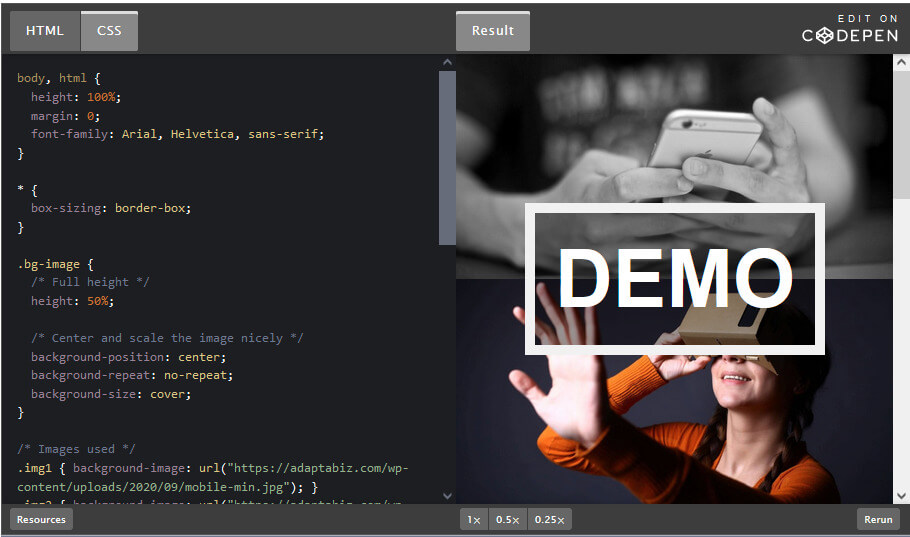What is Python?
The name of the Python programming language comes from an old BBC television comedy sketch series called Monty Python’s Flying Circus.
Founded by developer Guido van Rossum, Python is a high level, interpreted, and dynamic programming language used for the development of various applications such as web development, scientific computing, etc. Python, since its inception in 1991, has been that one language that is easy to learn and powerful to use; and therefore has been an excellent choice for beginners as well as big organizations like Google and Instagram.
Python’s simple, easy to learn syntax emphasizes readability and therefore reduces the cost of program maintenance. It supports modules and packages, which encourages program modularity and code reuse. Python has a broad set of powerful libraries that are used for neural networks, natural language toolkit, for interacting with windows, mathematical calculations, for TDD, GUI, web scraping, imaging processing, database management, game development, and data analysis.
Versions of Python
The following are the illustrations of different versions of Python along with the timeline
The two of the most used versions has to Python 2.x & 3.x. There is a lot of competition between the two and both of them seem to have quite a number of different fanbases.
For various purposes such as developing, scripting, generation and software testing, this language is utilized. Due to its elegance and simplicity, top technology organizations like Dropbox, Google, Quora, Mozilla, Hewlett-Packard, Qualcomm, IBM, and Cisco have implemented Python.
Why is Python so popular?
Python has been specifically designed to be a general-purpose language. The simplicity of Python and its easily human-readable syntax are two reasons why the language is so popular among seasoned coding professionals.
Python has been around for three decades, which has been plenty of time for a mature, supportive community to grow up around the language. From official documentation to tutorials, Python learners of all ages and skill levels can find the support they need to improve their knowledge of the language. Python is also a popular language in academia, where it’s used to introduce students to computer science as much as it’s used for in-depth research projects.
As a result of its strong community and corporate sponsorship, Python benefits from hundreds of different libraries and frameworks for developers to use. These add-ons to the basic Python language can greatly enhance your programs’ efficiency and cut down on the development time.
Some of the most popular Python libraries and frameworks are:
- Django for server-side web development
- NumPy for scientific computing
- BeautifulSoup for XML and HTML parsing
- SciPy for mathematics, science, and engineering applications
- Matplotlib for plotting graphs and charts
It occupies the high rank in the top ten of the PYPL PopularitY of Programming Language Index:

Comparing Python to Other Languages:
JavaScript
Python is an Object-oriented language used on a large basis for web and app development. Python is very useful in the field of Data Science and Rapid Application Development. While JavaScript is a programming language, if we discuss more specifically JavaScript is a scripting language because it embedded in HTML which is a markup language. Python supports a programming style that uses simple functions and variables without engaging in class definitions. However, for JavaScript, that’s all there is. Python, on the other hand, supports writing much larger programs and better code reuse through a true object-oriented programming style, where classes and inheritance play an important role.
Java
Java and Python have many similarities. Both languages have strong cross-platform support and extensive standard libraries. They both treat (nearly) everything as objects. Both languages compile to bytecode, but Python is (usually) compiled at runtime. They are both members of the Algol family, although Python deviates further from C/C++ than Java does. Python programs are generally expected to run slower than Java programs, but they also take much less time to develop. Python programs are typically 3-5 times shorter than equivalent Java programs. This difference can be attributed to Python’s built-in high-level data types and dynamic typing.
Python is much better suited as a “glue” language, while Java is better characterized as a low-level implementation language. In fact, the two together make an excellent combination. Components can be developed in Java and combined to form applications in Python; Python can also be used to prototype components until their design can be “hardened” in a Java implementation.
C#
C# (‘C-Sharp’) and Python are both object-oriented, high-level, and easy languages to learn and code, yet while C# is completely object-situated, designers can exploit Python to compose procedural code as well. Besides, Python is a powerfully translated language, while C# is a statically-composed accumulated language. They offer fast development and good performance and are both highly relevant languages in most fields.
C# is statically typed, can do more, is faster, but takes more time to learn and type. Python is dynamically typed, garbage collected, and easy to learn and type.
C# may somewhat beat Python in execution, yet since it doesn’t keep running on open-source advances, it removes these increases at the expense of framework programming.
Use of Python
You can use Python for developing desktop GUI applications, websites, and web applications. Also, Python, as a high-level programming language, allows you to focus on the core functionality of the application by taking care of common programming tasks. According to Cuong Do, Software Architect of YouTube, “ Python allows us to produce maintainable features in record times, with a minimum of developers”. There are many success stories with Python, showing that this programming language is helping numerous enterprises in achieving their business goals.
7 Important Reasons Why You Should Use Python
Code is easy to read and maintain: The effectiveness of the application greatly depends on the quality of its source code. A robust application needs a powerful programming language that is easy to read, update and maintain. Python incorporates all these qualities. It offers everything that is needed to build amazing applications, utilities, and frameworks.
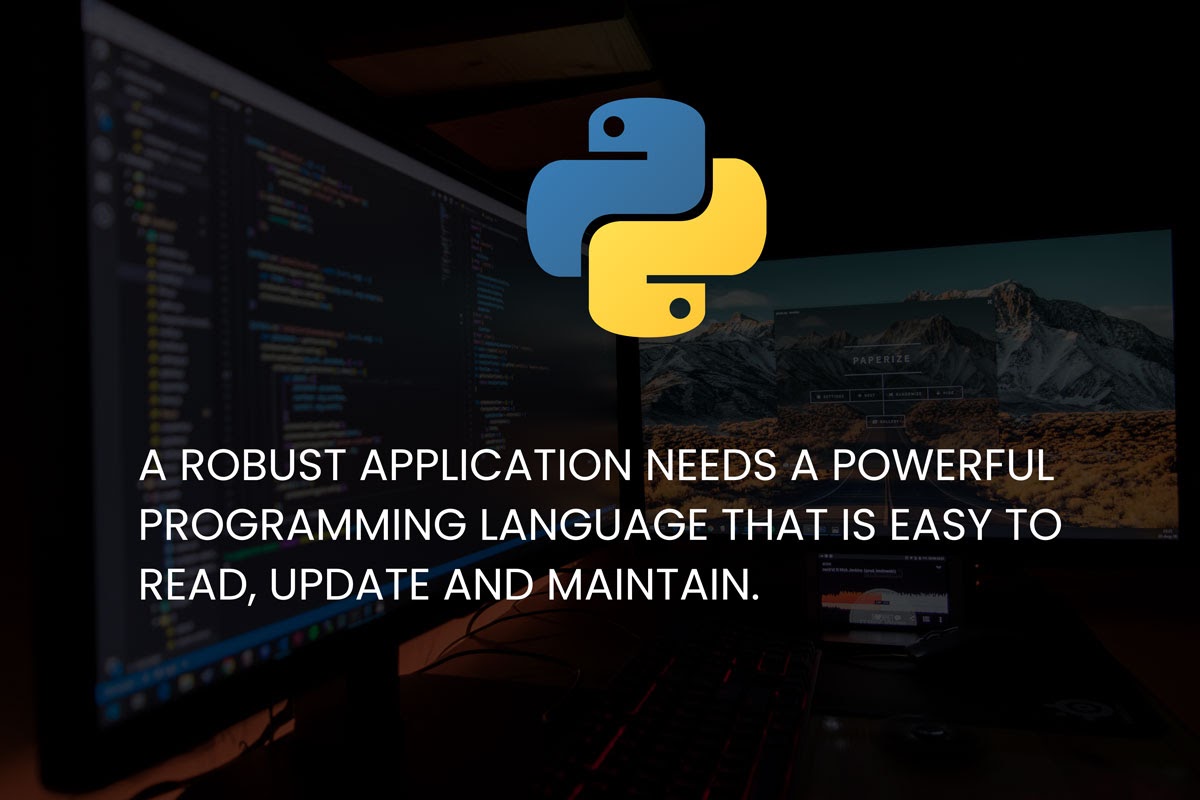
- Supports multiple programming paradigms: Every programming language has different working paradigms and a programmer should know what is more suitable as per the work requirement. Python supports many programming paradigms. Its capable features support various concepts specifically related to functional and aspect-oriented programming. Python also features a dynamic type system and automatic memory management.
- Compatible with Major Platforms and Systems: Python supports many operating systems. It is also used for interpreting to run the code on specific platforms. Programmers also use Python to apply the same code to multiple platforms without recompilation. You can even redevelop the application by using the specific modified application code without recompiling. Also, it helps you to analyze the impact of changes made to the code immediately.
- Large standard library: Python has a robust and large standard library that makes it stand out from other programming languages. Its standard library contains a wide range of modules, operations and web service tools that you can select and use for your applications without writing additional code.
- Cost-effective approach: Python is an open-source programming language, meaning no licensing fees are required to use it. You can even use several open-source Python frameworks, libraries and development tools to curtail development time without increasing development cost.
Open-source Python frameworks: Django, Flask, Pyramid, Bottle, and cherrypy.
Python GUI frameworks and toolkits: PyQT, PyJs, PyGUI, Kivy, PyGTK, and WxPython.
- Simplify Complex Software Development: Python is a general-purpose programming language that allows you to develop desktop and web applications both. It also helps for simplifying the complex operations in scientific and numeric applications. Python is designed with features to facilitate data analysis and visualization. You can take advantage of the data analysis features of Python to create custom big data solutions without putting extra time and effort. It provides various APIs and data visualization libraries that enable engineers to represent data in a more effective and appealing way.
- Adopt Test Driven Development: You can use Python to create a prototype of the software application rapidly. Also, you can build the software application directly from the prototype simply by refactoring the Python code.
Test-Driven Development (TDD) Approach- Write a failing unit test
- Make the unit test pass
- Repeat
Python makes it easy for the development team to perform coding and testing simultaneously by adopting TDD methodology. It helps in shortening the development and testing cycle and reducing the time.
Python For Big Data
Python provides a huge number of libraries to work on Big Data. You can also work – in terms of developing code – using Python for Big Data is much faster than any other programming language. These two aspects are enabling developers worldwide to embrace Python as the language of choice for Big Data projects. The best part of Python is it can be easily migrated into any desired programming language of any data science or big data projects at any time.
The Benefits of Python in Big Data
- Data Visualization: Data visualization is the discipline of trying to understand data by placing it in a visual context so that patterns, trends, and correlations that might not otherwise be detected can be exposed. There are many visualization packages in Python programming language when compared with other programming languages.
- Data Processing: Data Processing can be presented in different kinds of encoding such as CSV, XML, HTML, SQL, and JSON, etc. Python can handle various encoding processes. Developers are free to load high data volume for data processing through python packages, and it does not limit the processing of data.
- Scalability: Python is the best programming language when it comes to scalability. It can quickly increase the processing speed of data whenever the count of data is increased.
- Compatibility with Hadoop: As Python big data is compatible, similarly Hadoop and big data are synonymous with each other. Hence, Python has been made inherently compatible with Hadoop to work with big data. Python consists of Pydoop package which helps in accessing HDFS API and also writing Hadoop MapReduce programming. Besides that Pydoop enables MapReduce programming to solve complex big data problems with minimal effort.
- Powerful Scientific Library Packages:
– Pandas: Pandas is a library which helps in data analysis. Besides that, it provides the required data structure and operations for data manipulation on time series and numerical tables.- NumPy: NumPy is the fundamental package for scientific computing with Python. It provides the support for linear algebra, random number crunching, Fourier transforms. Also, it supports multidimensional arrays, matrices with its extensive library of high-level mathematical functions.– SciPy: This python library package is used for technical and scientific computation. SciPy contains different modules for
— Optimization
— Linear algebra
— Integration
— Interpolation
—Special functions
— FFT
—-Signal and image processing
— ODE solvers– Mlpy: Mlpy is a Python module for Machine Learning built on top of NumPy/SciPy and the GNU Scientific Libraries. It provides many machine learning methods for problems and helps to find a reasonable compromise between modularity, reproducibility, maintainability, usability, and efficiency.
– Matplotlib: Matplotlib is a Python library for 2D plots of arrays. Matplotlib is a multi-platform data visualization library built on NumPy arrays and designed to work with the broader SciPy stack.
– Theano: Theano is a Python library that allows you to define, optimize, and evaluate mathematical expressions involving multi-dimensional arrays efficiently.
– NetworkX: NetworkX is a Python library for studying graphs and networks. It helps you to create, manipulate, and study the structure, dynamics, and functions of complex networks. It has various features like-
— Data structures for graphs, digraphs, and multigraphs
— Many standard graph algorithms
— Network structure and analysis measures– Scikit-learn: Scikit-learn is a machine learning library that complements NumPy and SciPy libraries. It has various features like –
- Classification
- Regression
- Dimensionality Reduction
- Model Selection.
- Clustering
- Preprocessing
- TensorFlow: TensorFlow is an open-source software library supported by Python for machine learning. It helps in building and training neural networks to –
- Detect patterns
- Decipher patterns
- Correlation
Python for AI and Machine Learning
Machine learning, in layman terms, is to use the data to make a machine make intelligent decisions.
Machine Learning, a prominent topic in Artificial Intelligence domain, has been in the spotlight for quite some time now. This area may offer an attractive opportunity, and starting a career in it is not as difficult as it may seem at first glance. Even if you have zero-experience in math or programming, it is not a problem. The most important element of your success is purely your own interest and motivation to learn all those things.
As AI and ML are being applied across various channels and industries, big corporations invest in these fields, and the demand for experts in ML and AI grows accordingly. Jean Francois Puget, from IBM’s machine learning department, expressed his opinion that Python is the most popular language for AI and ML and based it on a trend search results on LinkedIn.
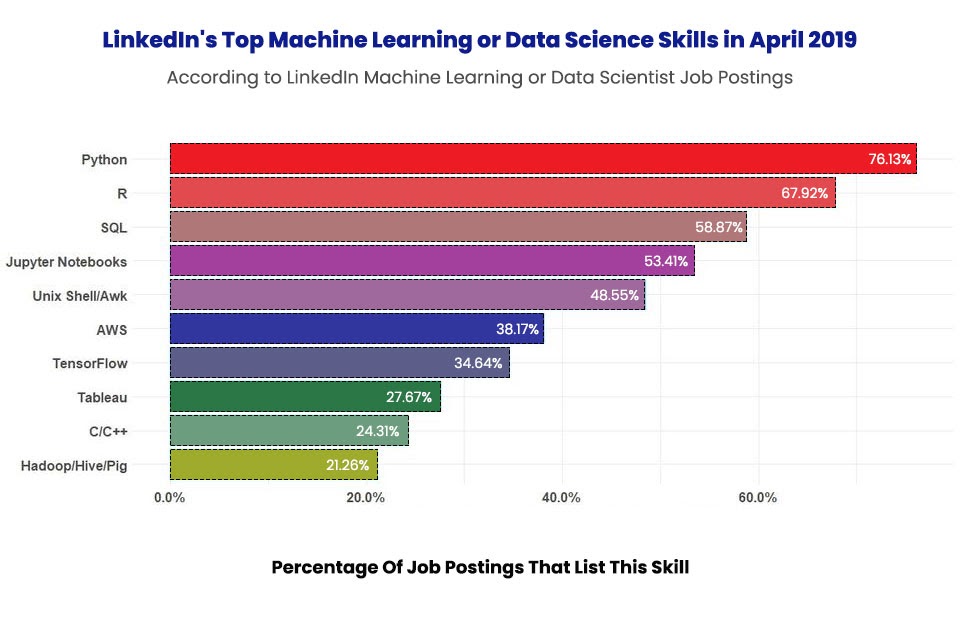
Python is a right choice for a beginner to make your focus on in order to jump into the field of machine learning and data science. It is a minimalistic and intuitive language with a full-featured library line which significantly reduces the time required to get your first results.
Various stages of machine learning:
- data collection:
- data sorting:
- data analysis
- algorithm development
- checking algorithm-generated
- the use of an algorithm to further conclusions
Two groups of various algorithms used to look for patterns:
- Supervised Learning: Supervised learning, an algorithm learns from a training dataset. We know the correct answers or desired output, the algorithm makes predictions using the given dataset and is corrected by the “supervisor”. The learning stops as and when the algorithm achieves a level of performance which is acceptable.
Two types of Supervised Learning:
- Classification: A classification is when the output variable is a category.
- Regression: A regression problem is when the output variable is a real value.
Some Supervised Learning algorithms include:
- Decision trees.
- Naive Bayes classification.
- Support-vector machine
- K-means
- linear regression
Unsupervised Learning: In unsupervised learning, there is no trainer or “supervisor” as the name suggests. We do not show the output, or the specific input required to achieve specific output. The machine learns based on its own capability, it decides what should be the input and output.
I wish you to have a lot of willingness and strength to learn!

